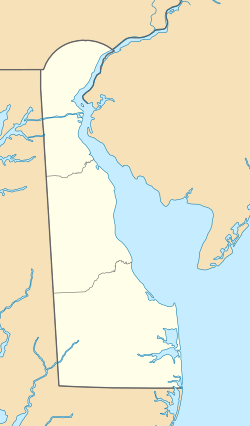Wright Potato House facts for kids
Quick facts for kids |
|
|
Wright Potato House
|
|
| Location | Southwest of junction of Delaware Route 24 and Road 510, near Laurel, Delaware |
|---|---|
| Area | 0.1 acres (0.040 ha) |
| Architectural style | Potato house |
| MPS | Sweet Potato Houses of Sussex County MPS |
| NRHP reference No. | 90001702 |
| Added to NRHP | November 15, 1990 |
The Wright Potato House was a special building near Laurel, Delaware. It was built to store harvested sweet potatoes. This small, 1+1⁄2-story structure was added to the National Register of Historic Places in 1990.
Contents
What Was the Wright Potato House?
The Wright Potato House was a building designed specifically for storing sweet potatoes. These buildings were very important for farmers in the past. They helped keep the potatoes fresh and safe after they were picked.
Why Were Potato Houses Important?
Sweet potatoes were a huge crop in Sussex County, Delaware. Farmers grew so many that they needed special places to store them. That's why many "potato houses" were built across the area.
However, in the 1940s, a plant disease called a blight affected the sweet potato crops. After this, growing sweet potatoes became less common. Many potato houses were no longer used. Some fell apart, while others were changed to serve different purposes.
How Was the Wright Potato House Built?
The Wright Potato House was made of wood. It measured about 20 feet (6.1 meters) by 30 feet (9.2 meters). It sat on a strong foundation made of concrete and brick.
The building had very few windows, mostly at its ends. The doors were also located at the ends. The outside walls had a special "triple sheathing" system. This included wood boards on the outside, a layer of diagonal wood boards, and straw for insulation. Inside, there were more wood boards. The roof, which was originally wood shingles, was later covered with asphalt shingles.
Inside the Potato House
The Wright Potato House was typical for its kind. It had a walkway down the middle. On both sides of the walkway, there were bins for storing potatoes. These bins were on two different levels.
A sliding trap door helped with air circulation between the two levels. The building also had a chimney. This allowed farmers to heat the house. Keeping the house warm was important to stop the stored potatoes from freezing in cold weather.
Sadly, the Wright Potato House no longer exists. It is listed as destroyed or demolished in the Delaware Cultural and Historic Resources GIS system.



